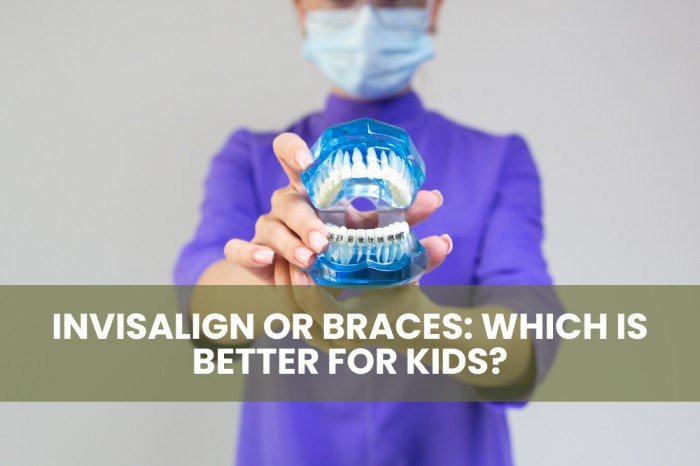As a parent, your top goal is to ensure your child possesses a healthy and confident smile. When it comes to orthodontic treatment, two leading options prevail: traditional braces and Invisalign clear aligners. Both treatments can fix crooked teeth, overcrowding, gaps, and bite misalignment, but which option is best suited for your child?
In this blog, we will discuss the pros and cons of both treatment options, contrast the differences, and share some important factors for you to consider before making a decision. Whether you are starting to explore your orthodontic options or comparing specific choices for your child, this blog will help you make a choice.
What are Braces?
Braces consist of brackets attached to the teeth connected by wires that slowly move the teeth into alignment over time. Orthodontic treatment using metal or ceramic brackets has been trusted for generations. Braces can correct a variety of dental issues, such as malalignment, crowding, and bite problems.
What is Invisalign?
Invisalign uses advanced orthodontic treatment and a series of custom-made clear aligners for every individual. Aligners are generally changed every one to two weeks to gradually shift the teeth into desired positions. Being virtually invisible and free from any metal, Invisalign is a comfortable option and a big plus for image-conscious children and young adults.
Invisalign vs Braces: A Side-by-Side Comparison
When it comes to orthodontic treatments, both traditional and clear aligners are effective solutions. There is a slight difference in look, comfort, and care. Let’s learn more about both.
| Feature | Braces | Invisalign |
| Visibility | Visible (metal or ceramic) | Nearly invisible |
| Comfort | May cause discomfort due to wires and brackets | Generally more comfortable; no metal |
| Removability | Fixed | Removable |
| Hygiene | More difficult to clean around brackets | Easy to clean, removable during brushing |
| Dietary Restrictions | Yes (avoid sticky and hard foods) | None (aligners can be removed while eating) |
| Treatment Time | Often 18–24 months | Similar or slightly shorter, depending on the case |
| Compliance Needed | Fixed (so always working) | Requires child to wear 20–22 hours/day |
| Cost | Generally less expensive | Often slightly more expensive |
Pros and Cons
Before making the final decision, let’s take a more profound look at the pros and cons of both.
Pros of Braces:
- Very useful in complicated dental complications.
- No compliance problems, as they are fixed in position.
- There are a lot of attractive options that include ceramic or colored brackets.
Cons of Braces:
- Certain children may have low self-esteem, as they are easily visible.
- The presence of metal wires and frequent corrections.
- Inadequate oral hygiene may cause the proliferation of potential plaque due to the difficulty of proper cleansing.
- Restrictions on diet may be discouraging to children.
Pros of Invisalign:
- Almost invisible and would be something many kids would like.
- Absence of wires, metal.
- More convenient to brush, eat, and floss.
- No broken wires or brackets.
Cons of Invisalign:
- Demands discipline as it has to be worn 20 to 22 hours a day.
- Risk of loss or damage if aligners are removed too often.
- It may not be suitable for very complicated dental problems
Factors to Consider When Choosing
Not only are the pros and cons, but there are also a few factors to consider before making the decision. They are
Age and Maturity of the Child
Invisalign requires maturity. It may be a terrific choice and could fit your child quite well, provided he or she is old enough to manage wearing the aligners and keeping treatment on track. However, fixed braces can be a better option for younger children.
Complexity of the Case
In cases of more severe thumb malalignment or difficulty biting, braces are usually prescribed. Depending on the dental structure, your orthodontist will be able to determine the usability of these Invisalign by evaluating the complexity.
Lifestyle and Self-Esteem
Children involved in athletics, music, or other social activities may prefer the discreet style of Invisalign. Additionally, adolescents often feel more confident wearing clear aligners compared to traditional braces.
Budget
Both treatment costs are becoming very competitive; however, Invisalign can sometimes be slightly more expensive depending on the treatment plan. Insurance is also a factor, so be sure to check your insurer’s orthodontic coverage.
No matter which option you prefer, the most important thing is to see a qualified orthodontist or dentist. They will assess your child’s specific needs, explain possible treatment steps, and recommend the best approach. Sometimes, kids start with braces and may switch to Invisalign later. depending on how they’re responding to the treatment. The secret to getting good results is staying flexible and working with experienced professionals.
Braces or Invisalign: What’s Right for Your Kid?
There is no single answer to the debate between Invisalign and braces; it truly depends on your child’s individual dental needs, lifestyle, and maturity level. Traditional braces remain the preferred option, especially for younger children or more complicated cases. For teens concerned about their appearance, Invisalign offers a comfortable and aesthetically pleasing alternative that they can responsibly manage. At STEPS Clinic, we understand that oral health is vital to your child’s overall well-being and self-esteem. That’s why our team of pediatric and orthodontic specialists in the UAE provides fully personalized treatments, ensuring your child receives the best possible solution effectively . Your child’s confident smile starts with us.
Book an appointment, and make an informed choice that sets them up for a lifetime of healthy smiles.

